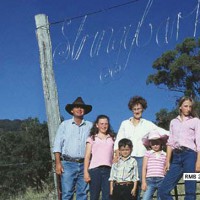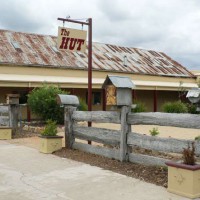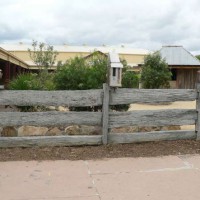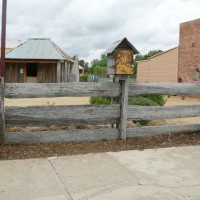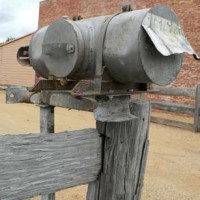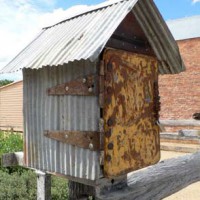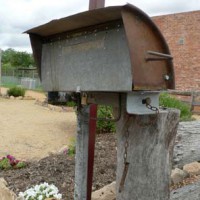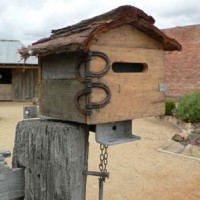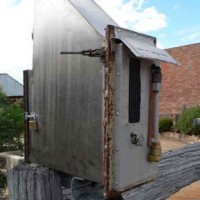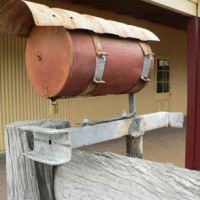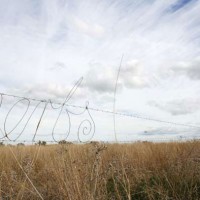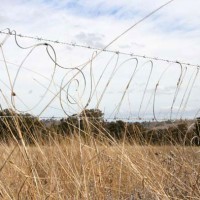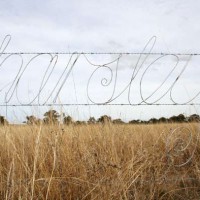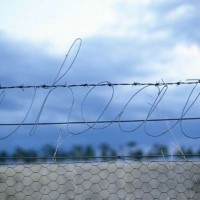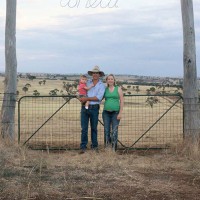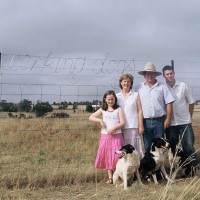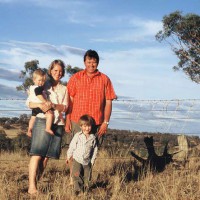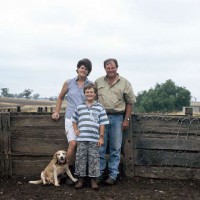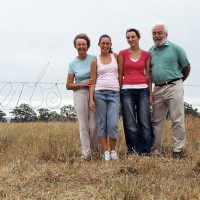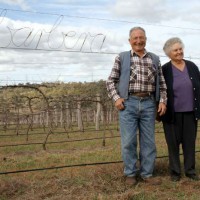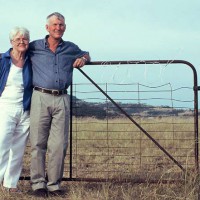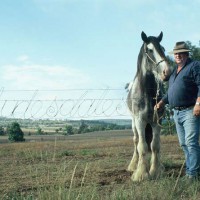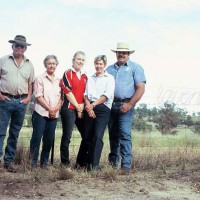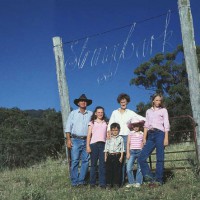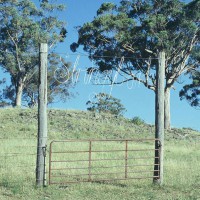RMB 2326 Merriwa Public Art Project
Materials:
Steel, stainless steel, stringybark timber and bark, sound recordings, audio players, cabling and postcards.
Concept:
In Merriwa, New South Wales you can hear voices of farmers echoing out along the Golden Highway telling tales of life on the land.
Roadside mailboxes are icons of regional Australia – outposts on the periphery of remote properties – marking the boundary between public and private. They are familiar daily objects, posted at junctures in vast archaic networks of communication. As depositories for information, their aesthetic value and innovative craftsmanship are often overlooked. These vessels bear witness to the stories and lives of generations of families, through the daily transactions that have passed through them.
The outcome of the Public Art Project consisted of six mailboxes, mounted on a fence outside the Merriwa Tourist Welcoming Centre on the town’s main street, which is a stretch of the Golden Highway – the halfway stop linking Dubbo approx 300km in the west and Newcastle approx 300km east on the coast. The mailboxes are wired up so a sound-scape of voices of local people can be heard telling stories of Merriwa; the voices speak out to travellers and passers by, echoing voices on the lonely highway.
Ten farming families participated in the project RMB 2329 Merriwa. They opened their homes, sheds and hearts and shared the anecdotal history of their lives on the land in a series of recorded interviews. From these discussions a word was written in fencing wire depicting the produce of each farm, the texts were then entwined into their immense boundary fences.
These ephemeral texts are submersed in the landscape all around Merriwa to this day. A series of photographic portraits of the families in their Sunday best was also produced, drawing on the ‘pose’ that one associates with 18th Century paintings, portraying the status of the family through connection with the property they own in the background. During a month of farm stays materials were donated from which the letterboxes were constructed. In each case the letterbox made for a farming family was only made from the materials found on that property – an artistic tactic to adopt the language of the place. This resourcefulness is akin to the ingenuity of farmers who, under tyranny of distance, learn to improvise. They are adept at creative problem solving, utilising what is at hand.
This project evolved in a two months residency during December 2005 and January 2006. At this time of year in Merriwa the average minimum temperature is thirty degrees centigrade and it is a dry scorching heat. The artist was billeted out in country homes with local families, and had many unforgettable experiences including bush fires and the elation of harvest time. The success of the residency was due to the willingness of the community to engage with the artist in the design and manufacture of a series of public art works, which involved community members and visitors in the project, promoted the contribution of farming families to the district, promoted local produce and created dynamic images of the Merriwa district.
RMB 2329: Merriwa Public Art Project promotes the people and produce of the Merriwa district and has inspired the Township Marketing Plan, which intends to build twenty more boxes to extend this concept down the remainder of the main street.
Project partners:
Crops for Hunter, Merriwa Economic Development Officer, Merriwa Tourist Welcoming Centre, New South Wales Regional Arts Development Officer – Arts Upper Hunter Inc., The University of Newcastle, Newcastle Australia.
Exhibitions:
Public Art and Alternative Tactics in Post-Acquisitive Society, Part One: Rural, Hellen Rose Schaumberger Labratorium, Surry Hills Australia. Dec 2008.
The forecourt of the Merriwa Tourist Welcoming Centre, The Golden Highway, Merriwa, New South Wales, Australia. Permanent public artwork officially launched 4th March 2006.
Publications:
FLANAGAN, P. & ROBERTSON, T. (2008) RMB 2329 The mailboxes are talking. Homestead magazine. Issue 3 ed. Boonah, Queensland, Miracle Media Pty Ltd. P. 27.
SAYER-JONES, M. (2008) RMB 2329, The Mailboxes are Talking. Big Story Country – Great Art Stories from Regional Australia. Adelaide, Regional Arts Australia. Pp. 7, 66 – 67, 84.
NEAVE, R. (2006) A Tribute to the Farmers. Art Reach – The Regional Arts NSW Magazine. Sydney, Regional Arts New South Wales. P. 26.
HOLT, E. (2006) Centre to Benefit Entire Community. Hunter Valley News. 8th Mar. ed. Muswellbrook, Australia. P. 4.
SMALL, J. (2006) Talking Mailboxes at Merriwa – Drop in and have a Listen. Crops for Hunter. Iss. 18, Feb. Merriwa, Australia. P. 7.
THOMPSON, F. (2006) Talking Letterboxes Shed Light on Farming Families. The Newcastle Herald. 23rd Jan. ed. Newcastle, P. 7.
HOLT, E. (2006) Reflecting Our Farm Families. Hunter Valley News. 18th Jan. ed. Muswellbrook, Australia. Front cover.
SHIPWAY, E. (2005) Artist in Residence. The Merriwa Ringer, 15 Dec.. P. 23.
SHIPWAY, E. (2005) Public Art. The Merriwa Ringer, 8th Dec.. P. 23.
Multi Media:
PRITCHARD, M. (2005) Interview with Tricia Flanagan. IN PRITCHARD, M. (Ed. Country Hour. Australia, Australian Broadcasting Commission. 29th Jan.
PRITCHARD, M. (2006) Merriwa Mailboxes. Radio National. Australian Broadcasting Commission. 31st Jul.
PRITCHARD, M. (2006) Merriwa Mailboxes. Rural – Upper hunter. Australian Broadcasting Commission. 7th Jul.
PRITCHARD, M. (2006) Merriwa mail boxes. 07/07/2006 ed.,
http://www.abc.net.au/rural/nsw/
content/2006/s1681372.htm.
Accessed 17th June 2009.
Thanks:
Funding support by the Commonwealth Regional Arts Fund, Australian Postgraduate Research Scholarship, with generous support from The University of Newcastle and Arts Upper Hunter.
